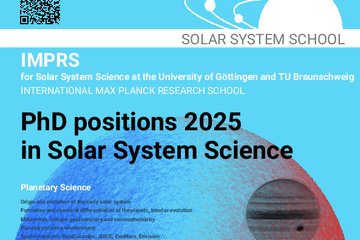Alexander Chizhevsky Medal for MPS Scientist
Dr. Theodosios Chatzistergos looks into the past of our star and analyzes historical solar observations. Now he has received an important award.
For his research findings on the historical activity of the Sun, the European Space Weather and Space Climate Association has honored Dr. Theodosios Chatzistergos from the Max Planck Institute for Solar System Research (MPS) in Germany with the Alexander Chizhevsky Medal. The award was presented yesterday during the European Space Weather Week in Coimbra, Portugal. In his research, the scientist looks into the past of our star and uses historical records and observational data to reconstruct how solar activity has developed over decades and centuries. Among other things, Chatzistergos has developed methods for combining solar observations from different eras and locations into coherent and scientifically meaningful data sets.

The Sun reveals its mood in different ways. In its active, more volatile phases, it often produces violent eruptions of particles and radiation, which can trigger, among other things, colorful auroras on Earth. Currently, we are experiencing such a phase. At the same time, during these periods many and large sunspots appear on the visible surface of our star. In lazier phases, their number decreases. As the dark spots can be detected with simple means, astronomers have been recording their number for more than three centuries. Other features that also indicate the Sun's state of activity, such as solar faculae, particularly bright areas on the solar surface, or various short-lived, elongated plasma structures in the layer directly above, have only been observed for just over a century. Such historical observations have in common that they provide a glimpse into our star's past. Only by looking back can we understand how active the Sun once was and how it has evolved. Among other things, this helps us to assess the extent to which fluctuations in solar activity affect Earth's climate.
“We can only obtain a complete picture of the Sun if we also consider its past,” said MPS Director Prof. Dr. Sami K. Solanki. “Theodosios Chatzistergos’ research results make a decisive contribution to expanding our understanding of the Sun beyond its current state and into the past.”
Counting dark spots
But analyzing historical solar observations is a daunting task - and not just because of the huge amount of data. The solar chroniclers of the past went about their work with different instruments, with different objectives and different attention to detail. “The difficulty lies in relating the data sets to each other in such a way that they become comparable,” explains Dr. Theodosios Chatzistergos. Only this creates a reliable historiography of the Sun that can be the basis for scientific research.
These difficulties are impressively demonstrated by historical records of the daily sunspot number. This quantity is regarded as a measure of solar activity - and at first glance appears to be easy to determine. In practice, however, different observers can arrive at different results: a more sophisticated telescope may reveal smaller spots than a simpler one; and which structures are interpreted as sunspots and which are not depends also on the observer’s personal preference. But the situation is not hopeless. Observation series often overlap in time and can therefore be related to each other, calibrated and standardized.
In recent years, Chatzistergos has succeeded in combining data from 314 sunspot observers from three centuries using new methods and thus significantly improving older reconstructions. This revealed, for example, that earlier efforts had at times overestimated the number of sunspots in the second half of the 19th century considerably.

The Sun in the light of individual wavelengths
In the course of the 19th century, it became technically possible and common to filter certain wavelength ranges from the sunlight and to image the solar disk separately in these wavelengths. Since 1892, for example, astronomers have been studying the violet light emitted by ionized calcium atoms from the Sun. It is mainly produced in the hot regions above solar faculae. As these regions shine particularly brightly, researchers need information about their number and size in order to estimate the Sun's irradiance in past times. Theodosios Chatzistergos was able to analyze 300,000 solar images from 42 archives and, for the first time, compile them into a complete chronicle of solar faculae reaching from 1892 to 2021.
The researcher also examined observational data from 1909 to 2022, which show the Sun in a special, narrow wavelength range of red light. This light originates from the hydrogen atoms in the Sun and reveals, among other things, dynamic, elongated plasma structures directly above the solar surface particularly clearly.
“Making historical solar observations usable for science is methodologically extremely demanding and very, very time-consuming,” said Dr. Natalie Krivova, who heads the ‘Solar Variability and Climate’ research group at the MPS, describing Chatzistergos' work. “Nevertheless, Theodosios Chatzistergos has succeeded in making almost all the examined data serviceable - even those that initially seemed almost hopeless,” she added.
The prizewinner
Dr. Theodosios Chatzistergos studied at the National and Kapodistrian University in Athens (Greece) and at Queen Mary University in London (England). In his doctorate, which he completed at the MPS in 2017, he worked on the reconstruction of historical fluctuations of solar irradiance. He continued this work during a two-year stay at the INAF Osservatorio Astronomico di Roma in Rome (Italy). Chatzistergos has been researching at the MPS again since mid-2020. Two years ago, he received the 2022 Distinguished Young Scientist Award of the Scientific Committee on Solar-Terrestrial Physics (SCOSTEP).
With the Alexander Chizhevsky Medal, the European Space Weather and Space Climate Association annually honors a scientist who is still at the beginning of their scientific career and has through an innovative approach already made outstanding contributions to the field of space weather and climate research.













